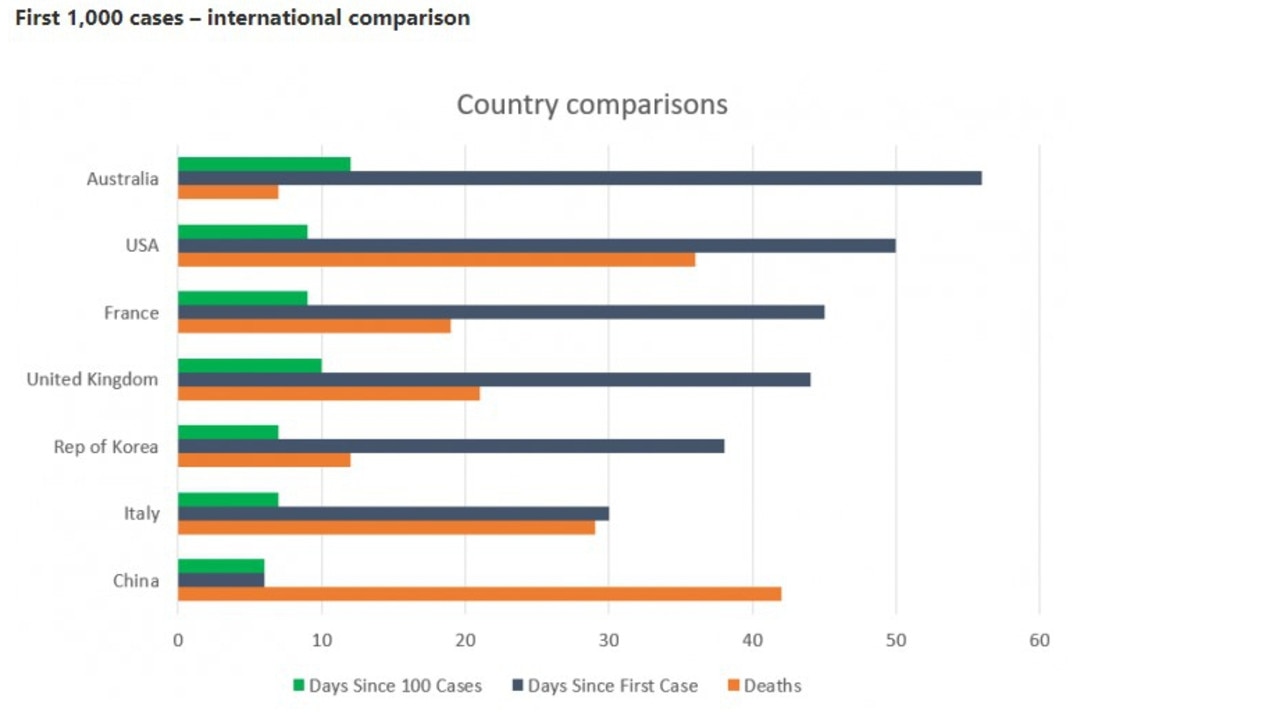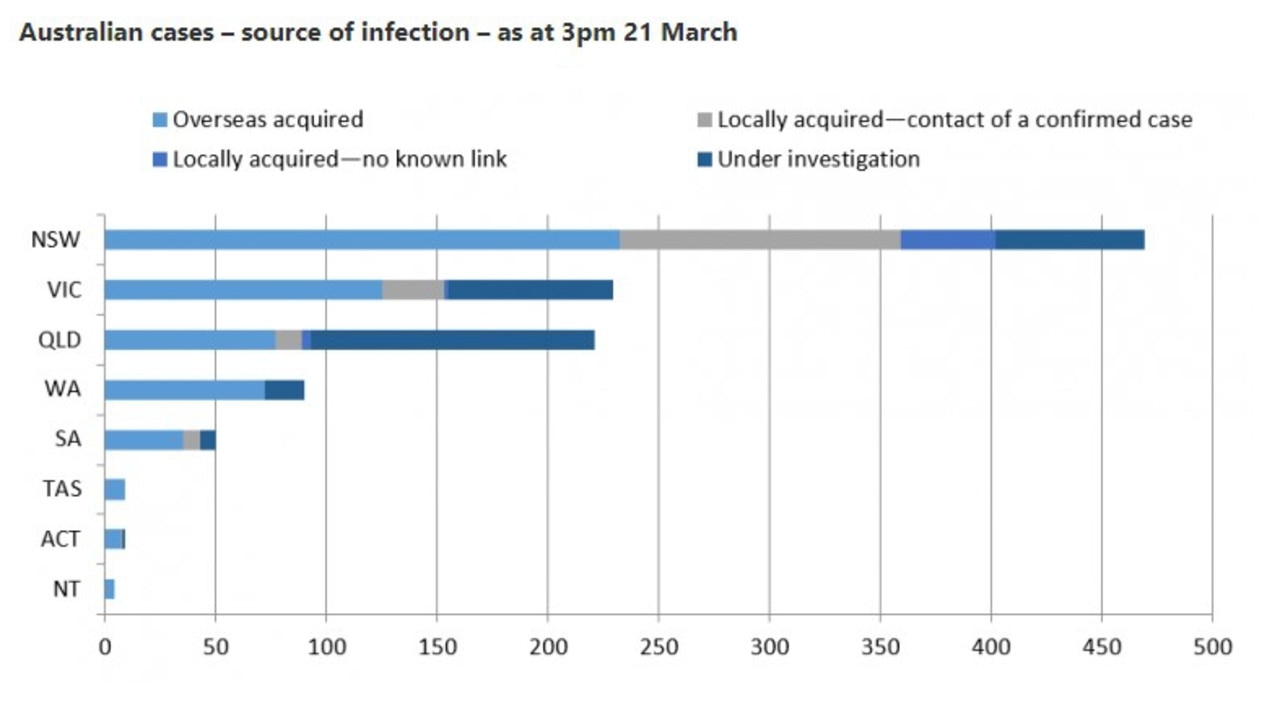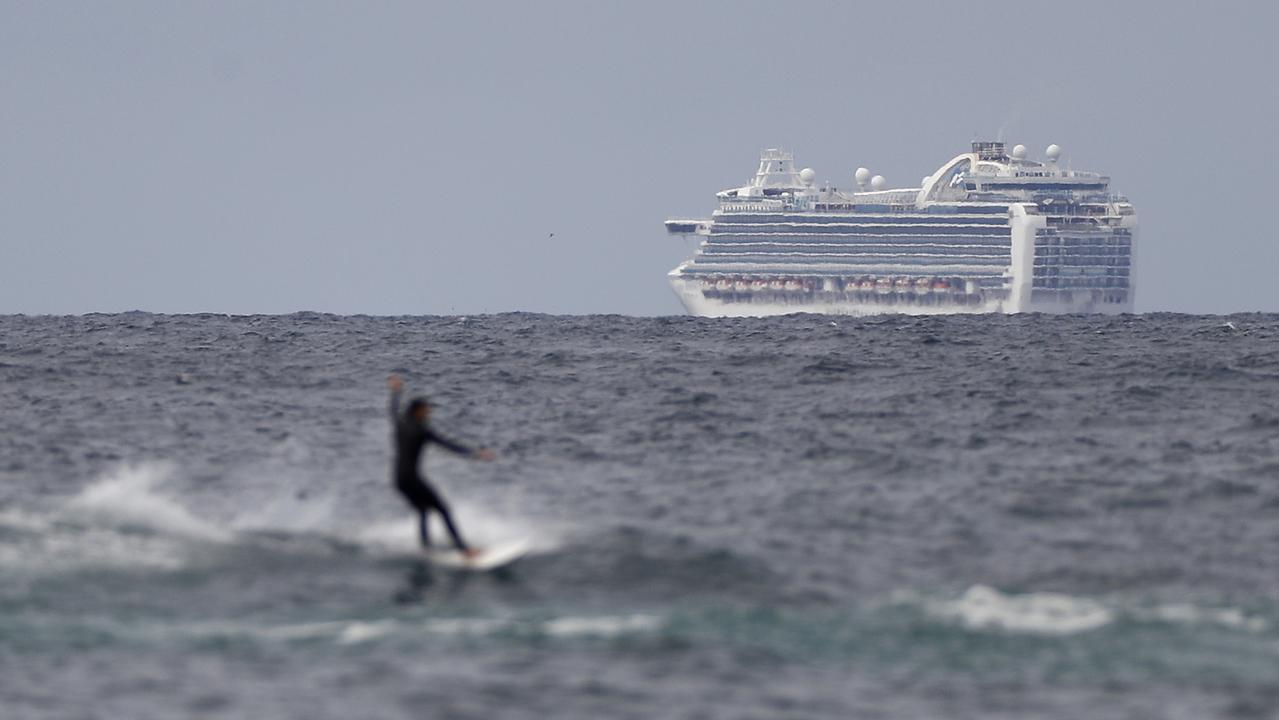Coronavirus Australia: Fewer deaths, hospitalisations in first 1000 cases
Coronavirus cases are growing exponentially in Australia but “something different” is happening here unlike in most of Europe and the US.
In what is a potential glimmer of good news for Australia, the spread of coronavirus appears to not be behaving in the same way here in comparison to other countries which are faced with being overwhelmed by the disease.
An analysis by the Australian Health Protection Principal Committee (AHPPC) found the trajectory of the first 1000 cases in Australia was “somewhat different” to Italy, the US and UK where deaths have been higher.
Australia passed 1000 cases last Saturday, March 21. Up to that point, only seven people had died and less than 20 had needed intensive care treatment.
That compared to more than 20 deaths in Britain, around 30 in Italy and 35 in the US at 1000 infections.
RELATED: Why the rise in new cases is 'good news'
RELATED: Countries coronavirus has been confirmed
That doesn’t mean COVID-19 is under control in Australia. The number of cases is still growing exponentially and doubling every few days.
On Tuesday, Australia had recorded more than 2000 cases with almost 3000 by Friday morning.
Yet the death toll is still relatively low at 13. However, despite the lower level of casualties the organisation said that an influx of infected cruise passengers as well as a number of “super spreader events” meant more needed to be done to keep a hold of coronavirus.
Part of the Department of Health, the AHPPC is the key body that advises on measures to take during health emergencies.
In a briefing from earlier this week, it said the difference in the death rate, as well as a number of other factors, could suggest there are fewer cases spreading unchecked under the radar in Australia than might have been expected.
“Without diminishing the significance of the rise in case numbers, it is worth noting that the situation with our first 1000 is somewhat different to that of other countries.
“More than half our cases are still imported from overseas or their direct contacts”.
Australia’s testing rate, at 480 per 100,000 people, could be another of the reasons. It’s less than South Korea but five times higher than the UK and a country mile ahead of the US.

It also has taken Australia longer to get from 100 to 1000 cases than many other nations.
“This suggests that we do not have as large a proportion of undetected cases in the population, as was likely the case in the USA, Italy and other countries.
“Our early detection and control work was effective.”
The virus is far easier to get a grip on if you know the route which infections are taking because you can isolate and treat people at risk. If it spreads widely in the community, that ability diminishes.
‘GOOD NEWS’
On Wednesday, Deputy Chief Medical Officer Paul Kelly said a dramatic rise in the number of Australian cases actually hid some “good news” which was “we are finding the cases and they are still mostly coming from overseas”.
The vast majority of cases had been “mild” said Professor Kelly and only 10 per cent of those infected had been hospitalised.
“We are not overwhelming the system.”
The AHPPC’s analysis showed that only 0.9 per cent of people tested for coronavirus in Australia actually had it, compared to 5 per cent in the UK and 13 per cent in the US. Since the AHPPC’s research, positive tests have risen in Australia to 1.5 per cent, said Prof Kelly on Thursday. But in the US positive results were now a massive 53 per cent.
Australia has now conducted 178,000 tests. “It's probably more on a per population basis than virtually anywhere else in the world,” Professor Kelly said.
Even South Korea, which is widely seen as a country which has successfully managed to bring some control to COVID-19, recorded 3 per cent of tests as positive, three times higher Australia.

NEED TO DO MORE, NOW
Nevertheless, the AHPPC said the numbers didn’t mean Australia has succeeded in the battle against coronavirus and community transmission rates were going up.
“Despite the (analysis), the recent rapid influx in imported cases and associated chains of transmission, including cruise ships and superspreader events, means we do need to do more now.
“The severe disease and death rate remain very low, but the test positivity rate is increasing. Weddings and religious services continue to feature in transmission events.”
The Ruby Princess cruise ship alone disgorged 120 COVID-19 cases in Sydney when it docked last week, with many of those fanning out across Australia. Earlier this month, 35 guests at a wedding at Stanwell Tops, on the NSW south coast, caught coronavirus. One of them was NSW Senator Andrew Bragg.
Worryingly, the AHPPC said that “small community outbreaks” in specific areas could now be taking place which was “clearly concerning”.
This morning, NSW Chief Medical Officer Dr Kerry Chant, said that at least 145 of the state’s 1405 cases could not be accounted for as being either from overseas of the close contact of a known case.
“The indicators that concern me most is the increase in community transmission where we don't have a source identified. That has been increasing and that is some cause for concern.”
The AHPPC said it was “too soon” to judge if social distancing and working from home was having a positive effect, “but we are seeing evidence of noncompliance with these new measures, people not taking this seriously”.
“The growth trajectory of cases in Australia and the incomplete and slow implementation of social distancing measures requires significantly stronger measures in social distancing in the short (initially for one month) term.”
The hope would be that the curve of new cases would flatten as social-distancing measures took effect.

The briefing came ahead of further restrictions, such as the closing of nail salons and enforced social distancing, imposed yesterday.
The AHPPC said it didn’t support a full lockdown as the “social disruption would be extreme” and compliance would be patchy.
But it was fully behind the current increased restrictions to social gatherings and closing of venues such as pubs and cinemas. And if the numbers didn’t improve, more action would likely be needed.
TRIGGER FOR FURTHER LOCKDOWNS
A recognised “trigger” for implementing further restrictions could be if local – rather than imported – transmissions exceeded more than half of all cases, which Australia is nearing.
However, this figure is not replicated across all states.
NSW has a chunk of locally acquired cases while Tasmania, South Australia and Western Australia have very few.
Instead, a rapid growth of overall cases in hot spots such Sydney, Melbourne, Brisbane and the Gold Coast could be the reason for further measures.
“A trigger for local lockdown provisions in a part (or parts) of the country (as seen in Italy and elsewhere) would be a substantial growth in locally transmitted cases, which could be predicted to exceed the future capacity of the region’s health services,” the AHPPC stated.
“More modelling will be conducted to refine such predictive measures.”
The AHPPC’s research has fed into comments from Prime Minister Scott Morrison that some future restrictions could be focused on separate states, or even regions, rather than country wide.




